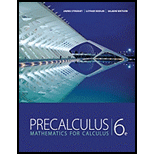
Concept explainers
(a)
To solve: given equation.
(a)
Answer to Problem 100E
The roots of
Explanation of Solution
Given:
Calculation:
Consider
Find the roots of
Use De Moivre’s Theorem to rewrite the roots. Recall that for a polynomial
In this case,
Thus, the quadratic formula gives:
Hence, the roots of
De Moivre’s Theorem is not necessary.
Conclusion:
Hence, the roots of
(b)
To solve: given equation.
(b)
Answer to Problem 100E
The roots of
Explanation of Solution
Given:
Calculation:
Consider
Find the roots of
In this case,
Hence, the roots of
De Moivre’s Theorem is not necessary.
Conclusion:
Hence, The roots of
(c)
To solve: given equation.
(c)
Answer to Problem 100E
The roots of
Explanation of Solution
Given:
Calculation:
Consider
Find the roots of
Use De Moivre’s Theorem to rewrite the roots. Recall that for a polynomial
In this case,
Thus, the quadratic formula gives:
Hence, the roots of
De Moivre’s Theorem is not necessary.
Conclusion:
Hence, the roots of
Chapter 8 Solutions
Precalculus: Mathematics for Calculus - 6th Edition
 Calculus: Early TranscendentalsCalculusISBN:9781285741550Author:James StewartPublisher:Cengage Learning
Calculus: Early TranscendentalsCalculusISBN:9781285741550Author:James StewartPublisher:Cengage Learning Thomas' Calculus (14th Edition)CalculusISBN:9780134438986Author:Joel R. Hass, Christopher E. Heil, Maurice D. WeirPublisher:PEARSON
Thomas' Calculus (14th Edition)CalculusISBN:9780134438986Author:Joel R. Hass, Christopher E. Heil, Maurice D. WeirPublisher:PEARSON Calculus: Early Transcendentals (3rd Edition)CalculusISBN:9780134763644Author:William L. Briggs, Lyle Cochran, Bernard Gillett, Eric SchulzPublisher:PEARSON
Calculus: Early Transcendentals (3rd Edition)CalculusISBN:9780134763644Author:William L. Briggs, Lyle Cochran, Bernard Gillett, Eric SchulzPublisher:PEARSON Calculus: Early TranscendentalsCalculusISBN:9781319050740Author:Jon Rogawski, Colin Adams, Robert FranzosaPublisher:W. H. Freeman
Calculus: Early TranscendentalsCalculusISBN:9781319050740Author:Jon Rogawski, Colin Adams, Robert FranzosaPublisher:W. H. Freeman
 Calculus: Early Transcendental FunctionsCalculusISBN:9781337552516Author:Ron Larson, Bruce H. EdwardsPublisher:Cengage Learning
Calculus: Early Transcendental FunctionsCalculusISBN:9781337552516Author:Ron Larson, Bruce H. EdwardsPublisher:Cengage Learning





